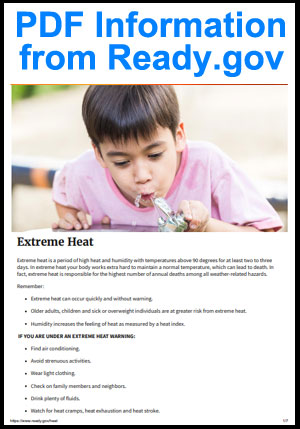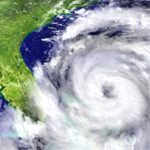Heat Wave
During a heat wave, the air gets so hot that sweat will no longer cool you down. Your body goes into overdrive trying to maintain a normal temperature. If you're exposed for too long, you'll die. Extreme heat causes more weather-related deaths per year in the United States than any other weather-related hazard, including floods, snowstorms and hurricanes.
Wikipedia Info
The World Meteorological Organization, defines a heat wave as 5 or more consecutive days of prolonged heat in which the daily maximum temperature is higher than the average maximum temperature by 5 °C (9 °F) or more. However, some nations have come up with their own criteria to define a heat wave.
In the United States, definitions also vary by region; however, a heat wave is usually defined as a period of at least two or more days of excessively hot weather.
In the Northeast, a heat wave is typically defined as three consecutive days where the temperature reaches or exceeds 90 °F (32.2 °C), but not always as this ties in with humidity levels to determine a heat index threshold.
A heat storm is a Californian term for an extended heat wave. Heat storms occur when the temperature reaches 100 °F (37.8 °C) for three or more consecutive days over a wide area (tens of thousands of square miles). The National Weather Service issues heat advisories and excessive heat warnings when unusual periods of hot weather are expected.
Severe heat waves have caused catastrophic crop failures, thousands of deaths from hyperthermia, and widespread power outages due to increased use of air conditioning. A heat wave is considered extreme weather that can be a natural disaster, and a danger because heat and sunlight may overheat the human body.
Original Wikipedia Link: https://en.wikipedia.org/wiki/Heat_wave
The summer of 2021 has become the hottest on record for human history. Climate scientists predict it will continue to get worse until we get climate change under control. To understand how those temperatures are registered, here's a handy chart from the National Weather Service.
The temperature sensor must be:
1. Out of direct sun & not affected by precipitation. Generally, a sensor is inside a beehive-shaped enclosure.
2. The enclosure is painted white to reflect sunlight.
3. The enclosure is 6 feet off the ground.
4. The enclosure is away from buildings, trees, or other obstructions.
5. Equipment is installed & maintened by the National Weather Service after going through rigorous testing at NWS's Sterling Field Support Center.
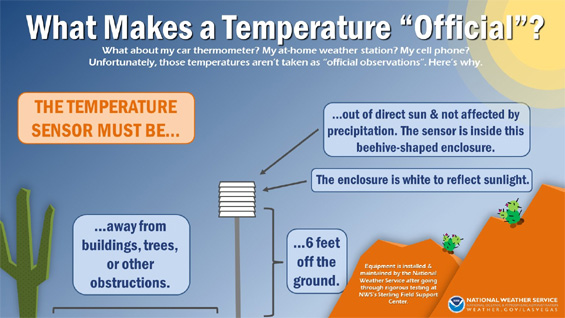
This image was provided courtesy of the National Weather Service.
Heat Index and Dew Point
The heat index and dew point are two ways to measure how it's going to feel when you get outside. But one measurement is a lot easier to use than the other. Here’s how they both work.
Think of the heat index as a measure of how hot it’s going to feel.
The heat index (also known as the apparent temperature) is what the temperature will feel like to the human body when relative humidity is combined with the air temperature.
When humidity and temperature are both high, your body reacts as if it’s hotter than the thermostat may indicate. If the heat index is above 90, you should limit your outside activities. If it’s above 105, hit the water or stay inside. There’s a convenient chart made by NOAA (The National Oceanic and Atmospheric Administration) that you can use to figure out what the heat index is going to be.
Reading the heat index chart is simple. You find the temperature along the top, then move down that column until you hit the row that matches the relative humidity. The number you land on is the heat index.
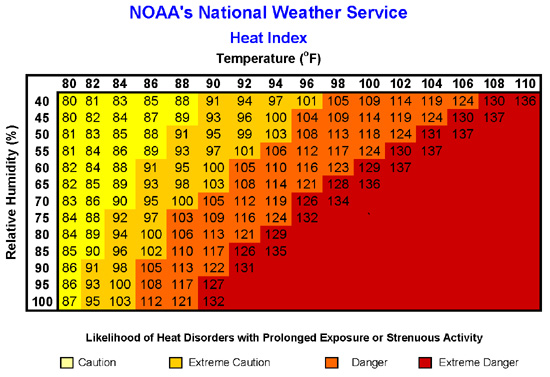
What the heat index numbers mean.
80 to 91 degrees Fahrenheit is a lower risk level, and you should take basic safety steps like wearing light reflective clothing, drinking plenty of water, and wearing head coverings.
91 to 103 degrees Fahrenheit moves the risk level to moderate, and you should be more careful monitoring your body temperature and how you feel.
103 and 115 degrees Fahrenheit moves you into the high-risk level, and it’s probably best to stay indoors and move outside activities to cooler times during the day.
115 degrees Fahrenheit or higher makes the risk very high to extreme, and you might not want to be outside at all.
The dew point is all about humidity.
Here’s the definition according to the National Weather Service.
“The dew point is the temperature the air needs to be cooled to (at constant pressure) in order to achieve a relative humidity (RH) of 100%. At this point the air cannot hold more water in the gas form. If the air were to be cooled even more, water vapor would have to come out of the atmosphere in the liquid form, usually as fog or precipitation.”
The simple explanation is this: The higher the dew point, the greater amount of moisture that’s in the air and the muggier you’re going to feel.
The big advantage of the dew point is that the measurement will always tell you how it will feel outside, regardless of the actual temperature or humidity. If you have a dew point of 55 degrees Fahrenheit, that will always feel comfortable. But if the humidity is 55%, it can feel very different depending on the temperature.
How to read the dew point numbers.
Dew Point Fahrenheit |
Dew Point Celcius |
How it Feels |
|
>75 |
> 24 |
Extremely uncomfortable, humid and miserable. | |
70–74 |
21–23 |
Very uncomfortable, humid and oppressive. | |
65–69 |
18–21 |
Moderately uncomfortable and humid. | |
60–64 |
16–18 |
Slightly uncomfortable, humid and feeling “sticky.” | |
55–59 |
13–15 |
Comfortable. | |
50–54 |
10–12 |
Very comfortable and pleasant. | |
32–49 |
0–9 |
Comfortable, but the air is drier. | |
< 32 |
< 0 |
Comfort varies, for some, the air may be too dry. |
Pay attention to the dew point when you go out, and pretty soon, you’ll know just how comfortable or uncomfortable you’ll feel when you’re outside. Remember this: As the dew point increases, it gets harder and harder for the body to cool itself. Sweat helps keep you cool by evaporating and creating a cooling effect. If the dew point is high, there’s more moisture in the air, so sweat doesn’t evaporate as quickly.
Here are some websites that post the dew point.
National Weather Service: https://www.weather.gov/arx/why_dewpoint_vs_humidity
Weather.com: https://weather.com/maps/currentdewpoint
Weather Street: https://weatherstreet.com/states/u-s-dewpoint-temperature-forecast.htm
Weather Underground: https://www.wunderground.com/
For those of you on vacation, watch the dew point closely. If it’s higher or lower than you’re used to, you need to adjust your outdoor activities accordingly.
Wet Bulb
The wet bulb temperature is the temperature read by a thermometer covered in a water soaked cloth, over which air is passed.
When it's hot, we sweat. That sweat cools us off as air moves across our body and the sweat evaporates. In humid environments like the tropics, more water hangs in the air. As the moisture level in the air increases, the sweat we produce can't evaporate, so we don't get as much cooling effect.
Traditionally scientists believed that our bodies couldn't regulate body temperature properly when the outside temperature hits 115 degrees Fahrenheit with 50 percent humidity. That drops to 95 degrees Fahrenheit when the humidity is at 100 percent.
When we can't regulate our body temperature, there's a dramatic increase in heatstroke and death.
When scientists did real-world tests, they found the maximum sustainable levels were much lower than previously thought. At 100 percent humidity, a temperature of just 87 degrees Fahrenheit can be deadly.
What Heat Does to Your Body
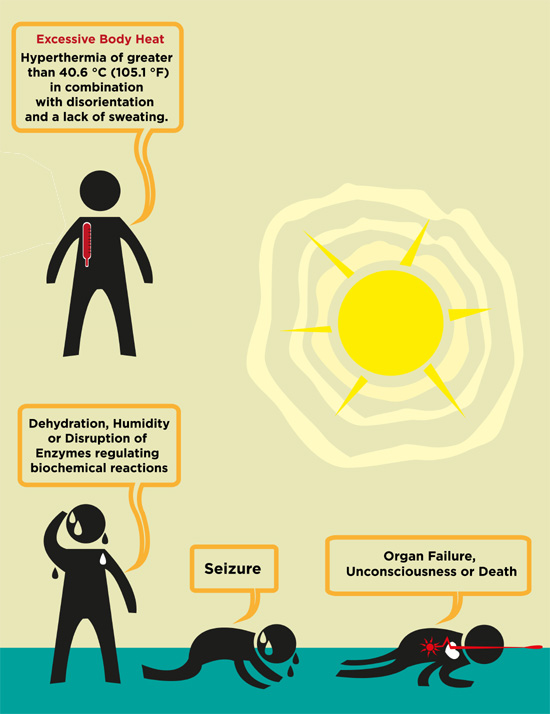
What are heat waves?
Did you know that you can have heat waves in winter as well as summer? And that fruit bats in Australia literally drop out of trees in the worst of the summer heat waves? No matter where you live in the world there are four main drivers of heat waves. Find out more from Dr Sarah Perkins-KIrpatrick from the ARC Centre of Excellence for Climate System Science (UNSW Sydney).
How to Survive a Heat Wave, According to Science
A heat wave can kill you. The sun and the high temperature can cause hyperthermia, which happens when your body absorbs more heat than it can process. So, how can you survive a heat wave? Well here’s how, According to Science.
What Not to do in a Heat Wave
CNN's Jennifer Gray provides four surprising tips on how to stay cool during this summer's heat waves.
How to Prepare for a Heatwave | Disasters
Past and Present Threats
With the relentless march of climate change, we see heat waves increase in intensity and duration. They're happening more often and during times of year that they didn't previously. Unfortunately, these are not trends that are slowing down. Until greenhouse gas emissions are brought under control, expect a future filled with ever more extreme heat wave events.
Preparation - Survival
Click Here for information on what to do from the United States government website, Ready.gov.
Click Here for 11 Tips for Surviving A Heat Wave Without Air-Conditioning
Click Here for the Red Cross Heat Wave Safety Information
Click Here to download a PDF file with information on what to do from the United States government website, Ready.gov.
Return to 101 Ways to Die Home Page
This information is presented to make people aware of the larger world around them. If you can prepare for something as devastating as this, you're much more likely to be ready for smaller disruptions. Be aware and prepare.
6/6/2020
Updated 4/15/2021
Updated 6/9/2021
Updated 7/7/2021
Updated 7/12/2021
Updated 2/27/2022
